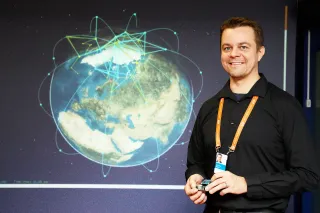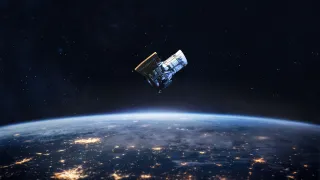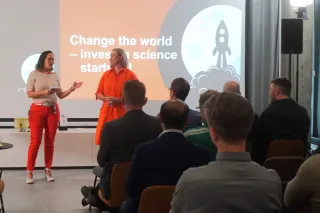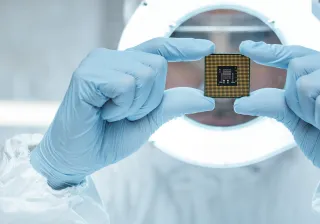Integrated terrestrial and satellite networks will provide the world with high-speed wireless 5G and internet connections and efficient data transfer. In this race, the low-earth orbit (LEO) satellites represent the hottest new technology now and in the coming years.
VTT has been working on the opportunities and challenges of the next generation 5G mobile networks and satellite connections integrated to them in collaboration with the European Space Agency (ESA) and other international partners. Marko Höyhtyä, New Space Co-creation Manager at VTT, has borne the main responsibility for drafting a vision paper "5G and Beyond for New Space: Vision and Research Challenges".
– The new technologies are developing at an amazing speed. In these activities, public operators and private enterprises have a major role to play. And these projects are not carried out for the pure joy of research; any reviews made by researchers also need to take a stand on market developments. Often, the projects are also implemented in collaboration with industrial partners. The new communications networks will certainly not run out of markets and users, Höyhtyä says.
Users need reliable cybersecurity
The challenges in the development work include network management and information security issues, resulting from the integration of various networks. On the other hand, the use of a wider range of technologies and bandwidths enables effective countermeasures against attacks.
The important user groups are envisioned to include not only shipping but also other modes of transport on the land and in the air, as well as autonomous vehicles, machines and equipment. Self-driving cars need sure-fire and high-speed connectivity, and they are equally important also for, say autonomous excavators and mining equipment or other industrial machines and equipment.

Low-earth orbit guarantees short network delays
High-frequency LEO satellites orbit only 500−2,000 kilometres above the ground, so they have significantly lower latency, or network delay, than geostationary satellites with a higher earth orbit. That is exactly the reason why this technology plays a major role in the future scenarios of the internet and mobile communications as a whole.
– Unlike the geostationary satellites at an altitude of up to 36,000 kilometres, LEO satellites are in constant motion in relation to the ground, and the connections provided by them may cover all regions on the globe. Radio signals travel at the speed of light, but you do notice the delays caused by the long distance in speech, for example," Höyhtyä says, describing a constellation of LEO satellites sweeping the surface of the earth one after another versus, for example, geostationary satellites remaining stationary above the equator.
One of the priority areas in satellite connectivity research are software-defined satellites. In plain language, it means that geostationary satellites in high orbit have been impossible to adjust or repair during their typical useful life of 15 years.
– In the new satellites, software can be updated as technology develops or, for example, the coverage area of a flying satellite can be dynamically shifted according to need, Höyhtyä says, explaining what software orientation means in earth orbit.
Benefits from border control to forest monitoring
According to Höyhtyä, new communications systems will be particularly beneficial for those moving in the Arctic areas and northern seas, where shipping is increasing all the time anyway. They also provide better connectivity for sparsely populated areas, making it easier, for example, for authorities to carry out search and rescue operations.
In the kind of future envisioned in the 5G and Beyond report, one of the groups reaping the biggest benefits from the new technology are authorities. Border control will become easier, and such environmental catastrophes as forest fires and oil spills can be spotted faster with the help of new integrated solutions.
– Satellites can carry different thermal imaging or hyperspectral imaging technologies, which enable, for example, surveillance of any major troop movements in neighbouring countries or crisis areas. Naturally, thermal imaging cameras cannot distinguish individual people, but the movements of large amounts of troops or missile launches can be detected, Höyhtyä says.
According to him, in the forestry sector there is already a special Forestry TEP programme, funded by ESA, being carried out, where satellite images are used for monitoring forest growth and felling volumes in different countries and continents. In other words, the satellites can serve many purposes.
Satellites also play a major role in the overall security of a small country like Finland in such matters as infrastructure maintenance, communications among authorities and general safety and security.
Enterprises racing to the new frontier
The business world has already initiated a race to the low-earth orbit, typically, the hi-tech companies of Silicon Valley leading the way. In May, SpaceX launched 60 satellites into space, and the company intends to build a network of more than 40,000 satellites. Its competitor Blue Origin has applied for a permit for over 3,000 satellites. OneWeb aims to begin provision of a commercial service by the end of 2020.
– The largest European aircraft and satellite manufacturer Airbus holds good positions in the race and so does its American rival Boeing. The IT giant Google has its own plans for balloon-based solutions, which at their highest would fly at the altitude of 21 kilometres, i.e. well below LEO satellites. The acronym used for such devices and technologies is HAP (high-altitude platforms), Marko Höyhtyä says.
Finnish firms operating in the space technology and satellite sector include Reaktor Space Labs and Iceye, with which VTT is also collaborating.
– As said before, private enterprises and their innovations play a major role in the development of integrated satellite and terrestrial networks. Business sector support is also needed in the funding of the projects, Marko Höyhtyä says and adds that, as we know, it costs quite a lot of money to launch satellites.
Finland has its own national space strategy
Since 1990s, VTT has been collaborating with ESA, and the recently launched strategic co-operation in the development of the 5G and Beyond technology will cover the next three years.
Finland has its own national space strategy, extending until 2025, aimed at making Finland the world's most attractive and agile space business environment which benefits all companies operating here. Business Finland is actively promoting this goal with its own space programme. The objective is to create a new economic pillar for Finland out of space technology and other relevant business operations (New Space Economy).
Many of these topics will be visibly highlighted when Finland organises the EU Space Week event as part of Finland's Presidency of the Council of the European Union.




